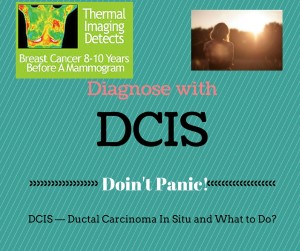DCIS — Ductal Carcinoma In Situ and What to Do?

Well, they did it again. After years of scaring the daylight out of women—basically making women fear their own breast, the medical community changed another directive, this time about Ductal Carcinoma In Situ, DCIS. In the news for the last couple of days is this heading for example:
Doubt Is Raised Over Value of Surgery for Breast Lesion at Earliest Stage
http://www.nytimes.com/2015/08/21/health/breast-cancer-ductal-carcinoma-in-situ-study.html
What is DCIS? Ductal carcinoma in situ (DCIS) is the most common type of non-invasive breast cancer. Ductal means that the cancer starts inside the milk ducts, carcinoma refers to any cancer that begins in the skin or other tissues (including breast tissue) that cover or line the internal organs, and in situ means “in its original place.” DCIS is called “non-invasive” because it hasn’t spread beyond the milk duct into any normal surrounding breast tissue. DCIS isn’t life-threatening, but having DCIS can increase the risk of developing an invasive breast cancer later on.
DCIS is usual detected by a mammogram. First thing to do if your doctor tells you that you have DCIS is DON’T PANIC! I have heard of women becoming so terrified when they hear DCIS ( considered Stage 0) that they have a prophylactic mastectomy. Is this really the right course of action?
Dr. Susan Love, a surgeon, is best known as the author of the top-selling “Dr. Susan Love’s Breast Book,” said the angriest patient she ever treated was a woman who was diagnosed with breast cancer years after a double prophylactic mastectomy.
The second thing to do after a DCIS diagnose, and after consulting with your doctor about the right course of action (some will suggest wait and see, and some physicians will want to be more proactive and do a lumpectomy) is getting a breast thermogram, also known as Digital Infrared Imaging.
Early Stage Malignant tumor

This is the specific area of a small DCIS. You can see the vascular feed and the discreet area of hypothermia that is displacing the surrounding hyperthermia.
A breast thermogram is an excellent way to:
See if there is a vascular feed to the DCIS which is an indication that it is cancerous and aggressive treatment should be sought.
A excellent way to monitor a suspicious area for years in case it does change or progress into cancer, or if no change peace of mind to do nothing invasive.
Here is a podcast where I interview Rita Rimmer, a certified thermographer, on breast health.
Below is a JAMA article:
Breast Cancer Mortality After a Diagnosis of Ductal Carcinoma In Situ
http://oncology.jamanetwork.com/article.aspx?articleid=2427491
Speak to your doctor about not only a mammogram but also having a yearly breast thermography in conjunction is a intelligent way to insure that that you are proactive about your own breast health.
To find a certified clinical thermographer in your area, just Google “Breast Thermography.”
More reading on this subject. Knowledge is power!

 D5 Creation
D5 Creation